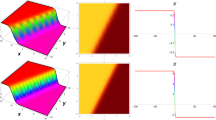Abstract
A detailed analytical and numerical investigation of Krause and Robert (KR) flow is done in this article. KR flow is directly derived from magnetohydrodynamics (MHD) equations by using dynamo theory that describes the process through which a rotating, convecting and electrically conducting fluid acts to maintain a magnetic field. The present work focuses on describing complex behavior and symmetry in KR flow. The existence of symmetry has a profound and far-reaching impact on the properties of solution of chaotic dynamical systems. The relation between the KR chaotic attractor with twofold symmetry and its projected image without symmetry is shown in this article. Chaotic behavior of KR flow is studied through Lyapunov spectrum and boundedness to specify the chaotic region. Moreover, the computation of the Hamilton energy shows that KR flow depends on all its variables and, therefore, enough energy is critical to generate wings of KR flow.









Similar content being viewed by others
References
Ahandani MA, Ghiasi AR, Kharrati H (2018) Parameter identification of chaotic systems using a shuffled backtracking search optimization algorithm. Soft Comput 22:8317–8339
Aqeel M, Azam A, Ahmad S (2017) Control of chaos: lie algebraic exact linearization approach for Lu system. Eur Phys J Plus 132:426
Azam A, Aqeel M, Ahmad S, Ahmed F (2017) Chaotic behaviour of modified stretched-twist-fold flow with fractal property. Nonlinear Dyn 90:1–12
Balcerzak M, Pikunov D, Dabrowski A (2018) The fastest, simplified method of Lyapunov exponents spectrum estimation for continuous-time dynamical systems. Nonlinear Dyn 94:3053–3065
Childress S, Gilbert AD (1995) Stretch, twist, fold: the fast dynamo. Springer, Berlin
Cicogna G, Gaeta G (1999) Symmetry and perturbation theory in nonlinear dynamics Berlin. Springer, New York
Crossley D, Jensen O (1986) The stochastic excitation of reversals in simple dynamos. Phys Earth Planet Interiors 42:143–153
Gerard L, Slotine J (2006) Neural networks and controlled symmetries, a generic framework
Gilmore R, Letellier C (2007) The symmetry of chaos. Oxford University Press, Oxford
Golubitsky M, Stewart I (2003) The symmetry perspective: from equilibrium to chaos in phase space and physical space. Birkhauser, Berlin
Koon WS, Marsden JE (1997) The Hamiltonian and Lagrangian approaches to the dynamics of nonholonomic systems. Rep Math Phys 40(1):21–62
Krause F, Roberts PH (1981) Strange attractor character of large-scale nonlinear dynamos. Adv Space Res 1:231–240
Lăzureanu C, Bînzar T (2015) Symmetries of some classes of dynamical systems. J Nonlinear Math Phys 22(2):265–274
Lorenz EN (1963) Deterministic non periodic flow. J Atmos Sci 20:130
Marsden J, Ratiu T (1994) Introduction to mechanics and symmetry. Springer, New York
Marwan M, Ahmad S, Aqeel M, Sabir M (2019) Control analysis of Rucklidge chaotic system. J Dyn Syst Meas Control 141(4):041010
Marwan M, Mehboob M, Ahmad S et al (2020) Hopf bifurcation of forced Chen system and its stability via adaptive control with arbitrary parameters. Soft Comput 24:4333–4341
Mehta PG, Hagen G, Banaszuk A (2007) Symmetry and symmetry-breaking for a wave equation with feedback. SIAM Dyn Syst Mag 6(3):549–575
Miranda R, Stone E (1993) The proto-Lorenz system. Phys Lett A 178:105–113
Oliver P (1986) Applications of lie groups to mechanics and symmetry. Springer, Berlin
Rajagopal K, Akgul A, Jafari S et al (2019) An exponential jerk system, its fractional-order form with dynamical analysis and engineering application. Soft Comput 24:7469–7479
Rikitake T (1958) Oscillations of a system of disk dynamos. Proc Camb Philos Soc 54(1):89–105
Rossler OE (1976) An equation for continuous chaos. Phys Lett A 57:397–398
Sarasola C, D’anjou A, Torrealdea FJ, Moujahid A (2005) Energy-like functions for some dissipative chaotic systems. Int J Bifurc Chaos 15(8):2507–2521
Shahverdiev EM (1999) Boundedness of dynamical systems and chaos synchronization. Phys Rev E Stat Phys Plasmas Fluids Relat Interdiscip 60(4):3905–3909
Spong MW, Bullo F (2005) Controlled symmetries and passive walking. IEEE Trans Autom Control 50(7):1025–1031
Wolf A, Swift JB, Swinney HL, Wastano JA (1985) Determining Lyapunov exponents from time series. Physica D 26:285–317
Ying J, Qin-Sheng B (2010) Symmetric bursting behaviour in non-smooth Chua’s circuit. Chin Phys B 19(8):080510
Acknowledgements
We are thankful to Higher Education Commission (HEC), Pakistan, and Institute of Space Technology (IST), Pakistan, for providing a good atmosphere to complete this research work.
Author information
Authors and Affiliations
Corresponding author
Ethics declarations
Conflict of interest
The authors declare that they have no conflict of interest.
Additional information
Communicated by V. Loia.
Publisher's Note
Springer Nature remains neutral with regard to jurisdictional claims in published maps and institutional affiliations.
Rights and permissions
About this article
Cite this article
Azam, A., Aqeel, M. & Hussain, Z. On the dynamics: existence of chaos and symmetry in Krause and Robert (KR) flow. Soft Comput 25, 2521–2530 (2021). https://doi.org/10.1007/s00500-020-05325-5
Published:
Issue Date:
DOI: https://doi.org/10.1007/s00500-020-05325-5




